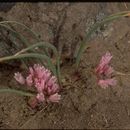en
names in breadcrumbs


Allium tolmiei (Tolmie's onion) is a plant species native to Idaho, eastern and central Oregon, southeastern Washington, northwestern Nevada and northeastern California. It occurs on mountains and scrublands at elevations of 1,300–9,200 feet (400–2,800 m).[3][4] It was discovered by and named for Dr. William Fraser Tolmie.
Allium tolmiei produces ovoid to oblique bulbs up to 0.79 inches (2 cm) long, the bulbs generally disappearing at flowering time but then reforming later. Flowers are bell-shaped, up to 0.47 inches (12 mm) across; tepals white to pink with reddish midribs; anthers purple or yellow; pollen yellow.[3][5][6][7][8]
Two varieties are currently recognized:[2][3]
Allium tolmiei (Tolmie's onion) is a plant species native to Idaho, eastern and central Oregon, southeastern Washington, northwestern Nevada and northeastern California. It occurs on mountains and scrublands at elevations of 1,300–9,200 feet (400–2,800 m). It was discovered by and named for Dr. William Fraser Tolmie.
Allium tolmiei produces ovoid to oblique bulbs up to 0.79 inches (2 cm) long, the bulbs generally disappearing at flowering time but then reforming later. Flowers are bell-shaped, up to 0.47 inches (12 mm) across; tepals white to pink with reddish midribs; anthers purple or yellow; pollen yellow.
Two varieties are currently recognized:
Allium tolmiei var. tolmiei - scapes 2.0–11.8 inches (5–30 cm) tall; stamens shorter than tepals Allium tolmiei var. persimile Ownbey (syn Allium persimile (Ownbey) Traub & Ownbey) - scapes 3.9–15.7 inches (10–40 cm) tall; stamens longer than sepals—known only from the Seven Devils Mountains in Idaho